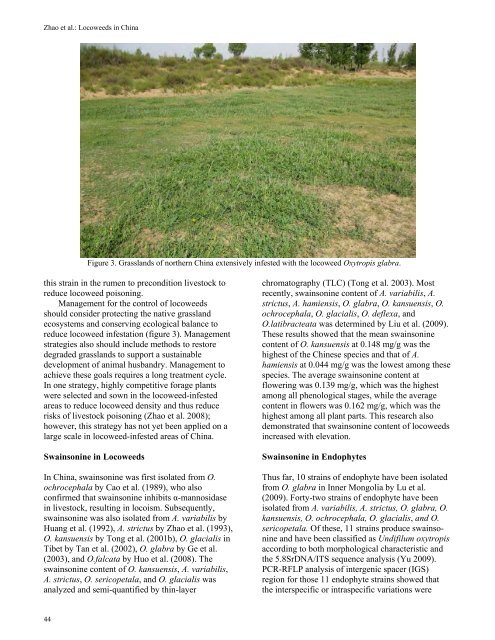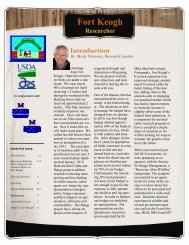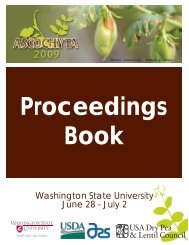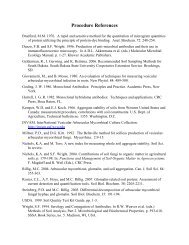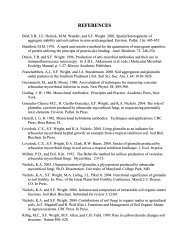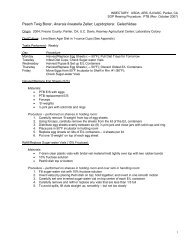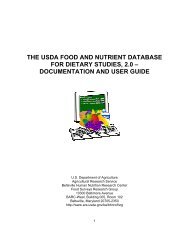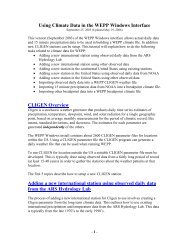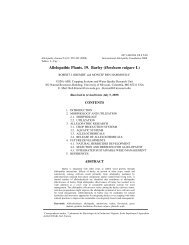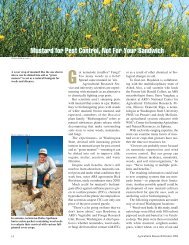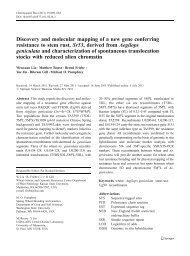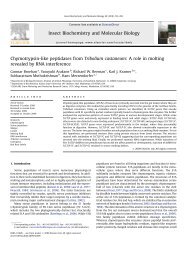International Journal of Poisonous Plant Research - Agricultural ...
International Journal of Poisonous Plant Research - Agricultural ...
International Journal of Poisonous Plant Research - Agricultural ...
Create successful ePaper yourself
Turn your PDF publications into a flip-book with our unique Google optimized e-Paper software.
Zhao et al.: Locoweeds in China<br />
44<br />
Figure 3. Grasslands <strong>of</strong> northern China extensively infested with the locoweed Oxytropis glabra.<br />
this strain in the rumen to precondition livestock to<br />
reduce locoweed poisoning.<br />
Management for the control <strong>of</strong> locoweeds<br />
should consider protecting the native grassland<br />
ecosystems and conserving ecological balance to<br />
reduce locoweed infestation (figure 3). Management<br />
strategies also should include methods to restore<br />
degraded grasslands to support a sustainable<br />
development <strong>of</strong> animal husbandry. Management to<br />
achieve these goals requires a long treatment cycle.<br />
In one strategy, highly competitive forage plants<br />
were selected and sown in the locoweed-infested<br />
areas to reduce locoweed density and thus reduce<br />
risks <strong>of</strong> livestock poisoning (Zhao et al. 2008);<br />
however, this strategy has not yet been applied on a<br />
large scale in locoweed-infested areas <strong>of</strong> China.<br />
Swainsonine in Locoweeds<br />
In China, swainsonine was first isolated from O.<br />
ochrocephala by Cao et al. (1989), who also<br />
confirmed that swainsonine inhibits α-mannosidase<br />
in livestock, resulting in locoism. Subsequently,<br />
swainsonine was also isolated from A. variabilis by<br />
Huang et al. (1992), A. strictus by Zhao et al. (1993),<br />
O. kansuensis by Tong et al. (2001b), O. glacialis in<br />
Tibet by Tan et al. (2002), O. glabra by Ge et al.<br />
(2003), and O.falcata by Huo et al. (2008). The<br />
swainsonine content <strong>of</strong> O. kansuensis, A. variabilis,<br />
A. strictus, O. sericopetala, and O. glacialis was<br />
analyzed and semi-quantified by thin-layer<br />
chromatography (TLC) (Tong et al. 2003). Most<br />
recently, swainsonine content <strong>of</strong> A. variabilis, A.<br />
strictus, A. hamiensis, O. glabra, O. kansuensis, O.<br />
ochrocephala, O. glacialis, O. deflexa, and<br />
O.latibracteata was determined by Liu et al. (2009).<br />
These results showed that the mean swainsonine<br />
content <strong>of</strong> O. kansuensis at 0.148 mg/g was the<br />
highest <strong>of</strong> the Chinese species and that <strong>of</strong> A.<br />
hamiensis at 0.044 mg/g was the lowest among these<br />
species. The average swainsonine content at<br />
flowering was 0.139 mg/g, which was the highest<br />
among all phenological stages, while the average<br />
content in flowers was 0.162 mg/g, which was the<br />
highest among all plant parts. This research also<br />
demonstrated that swainsonine content <strong>of</strong> locoweeds<br />
increased with elevation.<br />
Swainsonine in Endophytes<br />
Thus far, 10 strains <strong>of</strong> endophyte have been isolated<br />
from O. glabra in Inner Mongolia by Lu et al.<br />
(2009). Forty-two strains <strong>of</strong> endophyte have been<br />
isolated from A. variabilis, A. strictus, O. glabra, O.<br />
kansuensis, O. ochrocephala, O. glacialis, and O.<br />
sericopetala. Of these, 11 strains produce swainsonine<br />
and have been classified as Undifilum oxytropis<br />
according to both morphological characteristic and<br />
the 5.8SrDNA/ITS sequence analysis (Yu 2009).<br />
PCR-RFLP analysis <strong>of</strong> intergenic spacer (IGS)<br />
region for those 11 endophyte strains showed that<br />
the interspecific or intraspecific variations were


